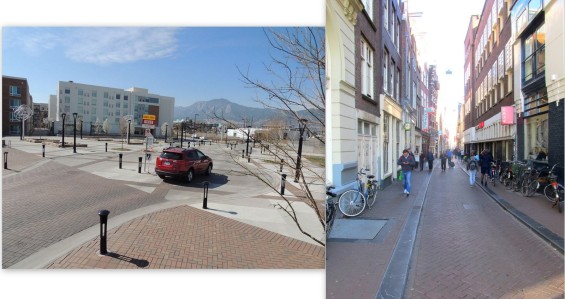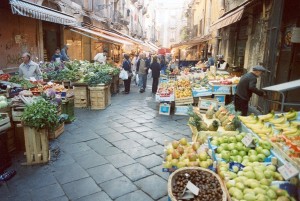By Dom Nozzi
September 11, 2003
Environmentalism should be considered a subset of new urbanist design principles.
This is because in recent years, New Urbanism has made — as its centerpiece — the “transect” concept. The urban to rural transect stipulates that community design and the land development regulations implemented to achieve that design must vary as one moves from urban to suburban to rural to nature preserve.
Environmentalism, while in theory taking in the entire universe, in practice tends to be a concept that only looks at the protection of natural, non-human ecosystems. Important as that is, it leaves out any guidance or direction for how the human habitat is best designed. Indeed, as some have pointed out, if a person intends to best promote environmental conservation, she or he must broaden their perspective because if they don’t understand  and successfully advocate for quality, walkable design for humans, efforts to protect non-human habitats are ultimately doomed, as growing numbers of humans flee the low quality human habitat for the promise of bliss in the undeveloped, unspoiled regions. By contrast, urbanists using the transect methodology have a tool that instructs on what must be done in all habitats — be they urban/human, suburban/sub-human, or ecosystem/non-human. The transect recognizes that one size does not fit all. Environmental scientists often (not always) act as if one size does fit all.
and successfully advocate for quality, walkable design for humans, efforts to protect non-human habitats are ultimately doomed, as growing numbers of humans flee the low quality human habitat for the promise of bliss in the undeveloped, unspoiled regions. By contrast, urbanists using the transect methodology have a tool that instructs on what must be done in all habitats — be they urban/human, suburban/sub-human, or ecosystem/non-human. The transect recognizes that one size does not fit all. Environmental scientists often (not always) act as if one size does fit all.
Unfortunately, there tends to be an anti-human attitude of many (not all) environmental advocates. This attitude tends to include the belief that all that is natural is equally valuable, no matter where it is located. It is better to preserve a vacant, weed-choked lot in the middle of a city (to protect, say, squirrel habitat) than to let it become an urban building. Compact, walkable, mixed use development is always evil, no matter where it is located, because it does not include oak forests or grasslands. Ultimately, by taking this position (which only concerns itself with the non-human habitat), we make high-quality human habitat illegal. We are forbidden to build a Charleston. Or a Venice. Or a Sienna. We must save every possible dandelion. Every toxic mud puddle in our city is a precious wetland. Why are we puzzled when so few want to live in American cities and so many want to live in (cocooned) woodlands surrounding a city?
Why are we not allowed to build pristine human habitats? Are we only allowed to preserve (or restore) pristine panther habitats? Are humans and their activity always to be considered evil or polluting? Is the idealized world one in which there are no humans and no human habitat?
When building compact, walkable, in-town projects in already developed, urbanized areas, the urbanist is simply looking for the same acceptance and societal admiration as the ecologist who preserves a wetland. The urbanist building a walkable, compact town center should not be attacked for not saving every weedy tree or degraded wetland in that location.
And I’ve seen that sort of thing from environmental activists all the time. Seems like an act of desperation to me. “We are losing so much woodland in sprawlsville. We therefore must make a stand to save every blade of grass everywhere.” Which, of course, ultimately speeds up environmental destruction due to how rarely we consequently build walkable places.
Should we attack the ecologist for not building sidewalks through every preserved wetland? If not, why is it okay to attack the urbanist for not preserving “nature” in every walkable place he or she builds? Why is only nature sacred, and never human urbanism?
We need to let the city be a city and let nature be nature.
Yes, I agree that we need to “push the market logic back to redevelopment.” But we live in a society that has poured trillions of dollars into building big roads that lock the market into fighting for remote sprawl. I believe it is naive to think that we can avoid a massive tidal wave of suburban sprawl when we have big roads and lots of free parking. No other tools, short of system-wide road diets and priced parking, can slow greenfield sprawl. Not environmental regulations. Not NIMBYs. Not no-growth commissioners. Not no-growth comprehensive plans. As long as we have lots of big roads and free parking in our community (and an absence of walkable places), we’ll see the vast majority of development proposals being made in greenfield areas. While I much prefer that those outlying greenfields be spared from development, I RELUCTANTLY accept the fact that I cannot stop the sprawl tidal wave that big roads bring. Given that agonizing reality, I much prefer that at least some of that tidal wave be in the form of walkable, compact, stand-alone villages (such as Haile Village Center in Gainesville FL).
And I eagerly await the revolution, when we move back from making cars happy to making people happy. Only then can we realistically expect to have a chance of stopping most greenfield development.
We have seen how extremely difficult it is to stop the tidal wave of drivable suburban development with a strong comprehensive plan — even with a majority of anti-sprawl commissioners. Such commissioners won’t stay in office forever. Not that it would matter, because even if they did, they would still be steamrollered.
To me, it is essential in this (hopefully) interim period of car-happy, big roads madness that we put walkable village standards into our code. In the end, if we don’t do that, we may win a few skirmishes by protecting a oak tree here and a weed-choked lot there, but we’ll still end up with the agony of the downward spiral of car-happy suburbia with no future. Will it be any consolation if there are tiny, degraded, preserved wetlands in the middle of a gigantic Wal-Mart Supercenter parking lots in a car happy community?
Should we just throw up our hands and give up in the only fight that really matters: stopping car-happiness and the road industry?





 hell. And my parents were very suburban in their values. As are my siblings, to this day.
hell. And my parents were very suburban in their values. As are my siblings, to this day. and successfully advocate for quality, walkable design for humans, efforts to protect non-human habitats are ultimately doomed, as growing numbers of humans flee the low quality human habitat for the promise of bliss in the undeveloped, unspoiled regions. By contrast, urbanists using the transect methodology have a tool that instructs on what must be done in all habitats — be they urban/human, suburban/sub-human, or ecosystem/non-human. The transect recognizes that one size does not fit all. Environmental scientists often (not always) act as if one size does fit all.
and successfully advocate for quality, walkable design for humans, efforts to protect non-human habitats are ultimately doomed, as growing numbers of humans flee the low quality human habitat for the promise of bliss in the undeveloped, unspoiled regions. By contrast, urbanists using the transect methodology have a tool that instructs on what must be done in all habitats — be they urban/human, suburban/sub-human, or ecosystem/non-human. The transect recognizes that one size does not fit all. Environmental scientists often (not always) act as if one size does fit all. Everglades (at least the inner core wetland area of the Prairie). Conversely, a 200-acre marsh is immersive in the Everglades and a transect violation in Charleston. In other words, something is immersive if it promotes the quality of the habitat being designed. It is a violation if it harms the quality of the habitat being designed.
Everglades (at least the inner core wetland area of the Prairie). Conversely, a 200-acre marsh is immersive in the Everglades and a transect violation in Charleston. In other words, something is immersive if it promotes the quality of the habitat being designed. It is a violation if it harms the quality of the habitat being designed.

 After all, at the end of the day, even if we have done all the mathematical calculations, run the computer models, and solved the equations, what are we left with? A pleasant community we are proud of? Or a place that only a Ford could love?
After all, at the end of the day, even if we have done all the mathematical calculations, run the computer models, and solved the equations, what are we left with? A pleasant community we are proud of? Or a place that only a Ford could love? charming, human-scaled people habitat.
charming, human-scaled people habitat.


